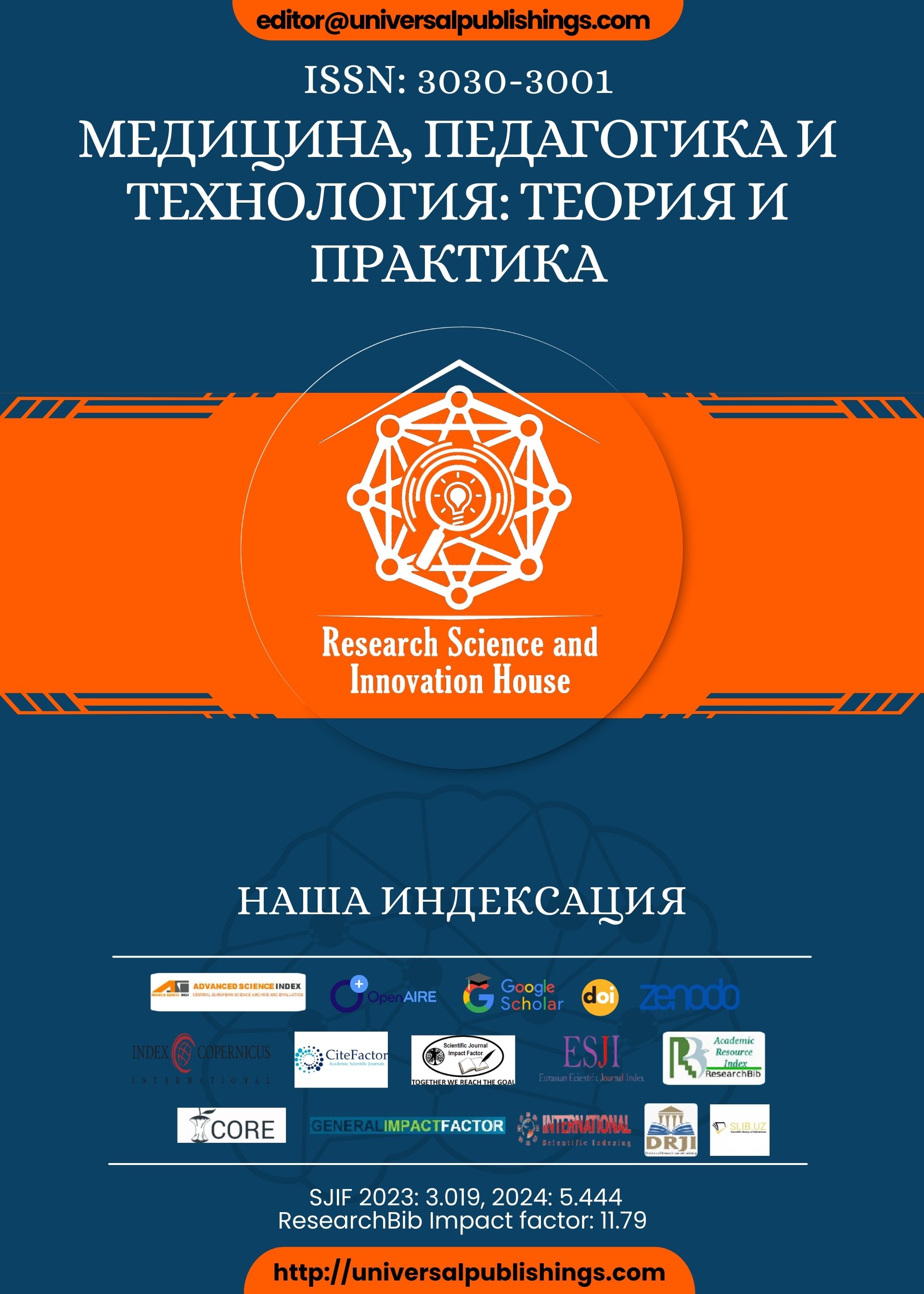Abstract
В этой статье обсуждается инструмент искусственного интеллекта в образовательных учреждениях. В нем исследуются преимущества и эффективные стороны обучения. Автор представляет аргументы в поддержку этого процесса, делает обзор использования реального языка в учебных программах и подчеркивает его влияние на общий академический успех. Кроме того, в статье признаются потенциальные проблемы и предлагаются предложения по их преодолению. В целом, он отстаивает важность инструмента искусственного интеллекта, который относится к подходу в преподавании и изучении языка, который отдает приоритет передаче смысла, а не явному фокусу на изолированных языковых формах, таких как грамматика и словарный запас, и ориентированному на форму обучению языку, которое относится к подходу в преподавании и изучении языка.
References
Copeland, B. J. (2022). Artificial intelligence. In Encyclopedia Britannica. https://www.britannica.com/technology/artificial-intelligence
Gligorea I, Cioca M, Oancea R, Gorski A-T, Gorski H, Tudorache P. Adaptive Learning Using Artificial Intelligence in e-Learning: A Literature Review. Education Sciences. 2023; 13(12):1216. https://doi.org/10.3390/educsci13121216
Hasanova, S. (2023). SYSTEM RELATIONS IN THE RUSSIAN LANGUAGE VOCABULARY. Modern Science and Research, 2(9), 72–74. Retrieved from https://inlibrary.uz/index.php/science-research/article/view/23900
Kolchenko, V. (2018). Can Modern AI replace teachers? Not so fast! Artificial Intelligence and Adaptive Learning: Personalized Education in the AI age. HAPS Educator, 22(3), 249–252. https://doi.org/10.21692/haps.2018.032
Liu, M. (2023). Exploring the Application of Artificial Intelligence in Foreign Language Teaching: Challenges and Future Development. SHS Web of Conferences, 168, 03025–03025. https://doi.org/10.1051/shsconf/202316803025
Oliveira, W., Hamari, J., Joaquim, S., Toda, A. M., Palomino, P. T., Vassileva, J., & Isotani, S. (2022). The effects of personalized gamification on students’ flow experience, motivation, and enjoyment. Smart Learning Environments, 9(1). https://doi.org/10.1186/s40561-022-00194-x
Ollomurodov, A. (2024). TRANSLATION FEATURES AND RESEARCH OF METAPHORS IN MODERN LINGUISTICS. MODERN SCIENCE AND RESEARCH, 3(2), 821–828.
Orifjonovich, O. A. . (2024). The Importance of Film Annotations in Analyzing Cinema Discourse. EUROPEAN JOURNAL OF INNOVATION IN NONFORMAL EDUCATION, 4(3), 252–257. Retrieved from https://inovatus.es/index.php/ejine/article/view/2711
Pan, F. (2024). AI in Language Teaching, Learning, and Assessment. IGI Global.
Seitbekova,, D. A. (2023). THE ROLE OF ARTIFICIAL INTELLIGENCE TECHNOLOGY IN TEACHING ENGLISH. Oriental renaissance: Innovative, educational, natural and social sciences, 3 (22), 133-137. https://doi.org/10.5281/zenodo.10198683
Seo, K., Tang, J., Roll, I., Fels, S., & Yoon, D. (2021). The impact of artificial intelligence on learner–instructor interaction in online learning. International Journal of Educational Technology in Higher Education, 18(1), 1–23. https://doi.org/10.1186/s41239-021-00292-9
Xasanova, S., & murodova, D. (2023). REPRESENTATION OF THE SYSTEMIC RELATIONS OF RUSSIAN VOCABULARY IN PROVERBS AND SAYINGS. Modern Science and Research, 2(10), 276–280. Retrieved from https://inlibrary.uz/index.php/science-research/article/view/24346
Xasanova, S. (2023). STRUCTURAL – SEMANTIC CHARACTERISTICS OF PROVERBS. Modern Science and Research, 2(12), 619–625. Retrieved from https://inlibrary.uz/index.php/science-research/article/view/27109
Хасанова Шахноза Баходировна. (2024). ИСПОЛЬЗОВАНИЕ ФРАЗЕОЛОГИЗМОВ ПРИ ОБУЧЕНИИ ПРОИЗНОШЕНИЮ, ГРАММАТИКЕ, ЛЕКСИКЕ И ПЕРЕВОДУ. МЕДИЦИНА, ПЕДАГОГИКА И ТЕХНОЛОГИЯ: ТЕОРИЯ И ПРАКТИКА, 2(4), 431–440. https://doi.org/10.5281/zenodo.10968956
Хасанова, Ш. (2024). PHRASEOLOGICAL UNITS OF THE RUSSIAN LANGUAGE. MODERN SCIENCE АND RESEARCH, 3(4), 128–133. https://doi.org/10.5281/zenodo.10936168
Баходировна , Х. Ш. . (2024). Из Истории Изучения Пословиц И Поговорок. Miasto Przyszłości, 46, 513–520. Retrieved from https://miastoprzyszlosci.com.pl/index.php/mp/article/view/2892
Хасанова, Ш. (2024). https://doi.org/10.5281/zenodo.10651477. MODERN SCIENCE AND RESEARCH, 3(2), 425–435. https://doi.org/10.5281/zenodo.10651477
Xasanova, S. (2024). DIFFERENCE BETWEEN PROVERB AND SAYING. MODERN SCIENCE AND RESEARCH, 3(1), 140–147. https://doi.org/10.5281/zenodo.10467418
Xasanova, S., & murodova, D. (2023). REPRESENTATION OF THE SYSTEMIC RELATIONS OF RUSSIAN VOCABULARY IN PROVERBS AND SAYINGS. Modern Science and Research, 2(10), 276–280. Retrieved from https://inlibrary.uz/index.php/science-research/article/view/24346
Xasanova, S. (2023). USING EXPRESSIVE VOCABULARY IN RUSSIAN PROVERBS. Modern Science and Research, 2(10), 403–408. Retrieved from https://inlibrary.uz/index.php/science-research/article/view/25248
Hasanova, S. (2023). SYSTEM RELATIONS IN THE RUSSIAN LANGUAGE VOCABULARY. Modern Science and Research, 2(9), 72–74. Retrieved from https://inlibrary.uz/index.php/science-research/article/view/23900
Баходировна, Х. Ш. (2023). Гендерная Лексика В Русском Языке. International Journal of Formal Education, 2(11), 324–331. Retrieved from http://journals.academiczone.net/index.php/ijfe/article/view/1505
Хасанова Шахноза Баходировна. (2023). РЕПРЕЗЕНТАЦИЯ СИСТЕМНЫХ ОТНОШЕНИЙ РУССКОЙ ЛЕКСИКИ В ПОСЛОВИЦАХ И ПОГОВОРКАХ. International journal of education, social science & humanities. finland academic research science publishers, 11(4), 1220–1226. https://doi.org/10.5281/zenodo.7847968
Xasanova, S. (2023). STRUCTURAL – SEMANTIC CHARACTERISTICS OF PROVERBS. Modern Science and Research, 2(12), 619–625. Retrieved from https://inlibrary.uz/index.php/science-research/article/view/27109
Nigmatova Gulnoz Khamidovna, & Khasanova Shakhnoza Bakhodirovna. (2022). System Relations in the Vocabulary of the Russian Language. Global Scientific Review, 3, 44–48. Retrieved from https://www.scienticreview.com/index.php/gsr/article/view/22
Shaxnoza Baxadirovna, X. (2023). PROVERBS IN THE LEXICOGRAPHICAL ASPECT. International Journal of Formal Education, 2(12), 429–437. Retrieved from http://journals.academiczone.net/index.php/ijfe/article/view/1771
Xasanova, S. (2024). DIFFERENCE BETWEEN PROVERB AND SAYING. Modern Science and Research, 3(1), 140–147. Retrieved from https://inlibrary.uz/index.php/science-research/article/view/27853
Xasanova, S. (2024). NAMES OF PERSONS IN RUSSIAN, UZBEK PROVERBS AND SAYINGS. Modern Science and Research, 3(2), 425–435. Retrieved from https://inlibrary.uz/index.php/science-research/article/view/29049
Хасанова, Ш. Б. (2023). ИСПОЛЬЗОВАНИЕ ВЫРАЗИТЕЛЬНЫХ ВОЗМОЖНОСТЕЙ ЛЕКСИКИ В РУССКИХ ПОСЛОВИЦАХ. Modern Science and Research, 2(10), 403–408. Retrieved from https://inlibrary.uz/index.php/science-research/article/view/25248

